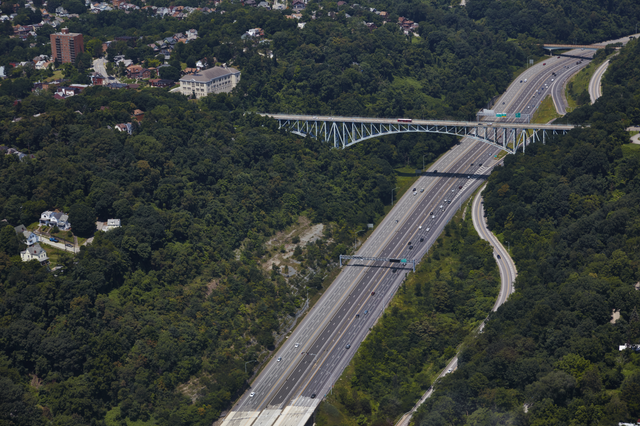Opinion | With all that cars have taken, why can’t we let them go?


U.S. Interstate Highway 279, heading northwest out of Pittsburgh, Pennsylvania.
Cake’s 2001 song “Comfort Eagle” — an unsubtle but witty critique of the American way — opens with an infomercial-esque pitch, with lead singer John McCrea droning, “We are building a religion, we are building it bigger / We are widening the corridors and adding more lanes.”
If we take these lyrics literally, it just about sums up transportation policy in this country. America is too busy sacrificing the environment and quality of our social fabric at the altar of car culture to pay much attention to how destructive it is. When this car-centric lifestyle hits a bump in the road — pun intended — our policy solution is usually more roads with more lanes, so that we can accommodate our some 289.5 million registered vehicles. This is especially evident in Pennsylvania, which continues to shovel money into highways at the expense of people and the planet.
Take, for example, the $117.8 million project on I-70 that will expand a section of the interstate from two to three lanes, despite the fact that this will probably do nothing to alleviate congestion. Induced demand, an economic concept describing how demand moves to fill excess supply, dictates that we’d be just as well off having a $117.8 million bonfire.
Or how about the new 13-mile, nearly billion dollar stretch of the Pennsylvania Turnpike that partially opened in October as part of the Southern Beltway project? This money would be put to much greater use funding public transportation, mitigating the effects of climate change or restoring neighborhoods torn apart by highways.
We’re likely to see another flurry of these wasteful projects, given that the bipartisan infrastructure bill contains $110 billion in new funds for the nation’s roads and bridges — compared to $39 billion for public transit. President Joe Biden initially wanted $85 billion for public transit, but the grueling negotiation process whittled this down. The new funds for roads and bridges also have no stipulation requiring they be put toward repairing existing roads, and can just as easily be spent on extending traffic capacity.
It’s remarkable how much money we’re willing to funnel into accommodating cars, despite all they’ve taken from us — these funds included. We can look within Pittsburgh to see the damage.
Downtown used to be home to a small but vibrant Chinatown packed with businesses and, at its peak, an estimated 500 residents. Unfortunately, the construction of the Boulevard of the Allies in the 1920s cut through the neighborhood, dispersing residents. Today, only one restaurant remains — the Chinatown Inn. The Boulevard cuts through many other Pittsburgh neighborhoods, including Oakland. It’s part of the reason that South Oakland proper feels so disconnected from the rest of the neighborhood.
The Hill District is the City’s most prominent example of the destruction wrought by major roadways. Constructed in the 1950s, I-579 severed the neighborhood from Downtown and, combined with the construction of Civic Arena and parking lots in the Lower HIll, involved the displacement of 8,000 mostly Black residents. In order to make room for automobiles, a thriving hub for arts, music and commerce once known as the “crossroads of the world” was gutted.
Current and former residents pay a social, economic and cultural price for this loss every day, as does the rest of the City. The City has begun to make much-belated amends with the Frankie Pace Park, which was dedicated earlier this month and reestablishes a connection between Downtown and the Hill District, but the damage caused by these so-called urban renewal projects can never be fully undone.
None of this is to mention the catastrophic damage our reliance on cars does to the environment. Automobiles are immensely energy-intensive to manufacture, they’re America’s largest source of carbon emissions and they are partially non-recyclable once they hit the junkyard. They’re also responsible for one-third of all air pollution in the country — a particularly pressing point given Pittsburgh’s abysmal air quality.
We also need to reckon with the ecological impact of new roads. Highways, such as the Southern Beltway project, split habitats in two — potentially putting food, water and mates out of reach for some animals. The chemical, noise and light pollution caused by cars increase mortality for animals and disrupt their biological processes. And of course, Pennsylvania drivers are all too familiar with roadkill.
Our insatiable appetite for bigger and better roads costs us our money, the fabric of our neighborhoods and the health of our environment. The dogma of car culture says we must widen the corridors and add a few more lanes — are we brave enough to rethink it?
Jack Troy writes primarily about local politics and being tired of capitalism. Write to him at jpt40@pitt.edu.
Recent Posts
Pitt loses overtime thriller to Clemson, drops fourth straight ACC game
Pitt men’s basketball (12-6, ACC 3-4) dropped its fourth straight game 78-75 to Clemson (14-4,…
Former Panther, “Bub” Carrington making magic with Washington Wizards
With first-overall pick Alex Sarr, the rise of sophomore and once-lottery pick Bilal Coulibaly and…
What, Like It’s Hard? // The waiting game
After a long winter break, contributing editor Livia LaMarca reflects on her time waiting for…
From Pop to Personal // Flu, Football and Fresh Starts
On this edition of From Pop to Personal, staff writer Ashley O’Doherty compares herself to…
Who Asked? // Do we secretly like cheaters?
This installment of Who Asked? by staff writer Brynn Murawski notices how common it is…
Couch Critic // Space movies: An unexpected comfort
In this week's Couch Critic, Emily Harris explores her newly discovered niche for space movies…

